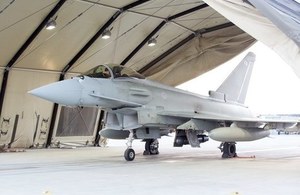Update: air strikes against Daesh
British forces have continued to conduct air operations in the fight against Daesh

Typhoon aircraft. Crown Copyright.
Latest Update
Daesh terrorists have been repeatedly struck in the last few days by Royal Air Force aircraft providing support to Iraqi ground forces.
RAF Tornado GR4s, Typhoon FGR4s and Reapers have continued to fly daily missions over Syria and Iraq. As well as gathering invaluable intelligence on terrorist activity, they have conducted a large number of successful air strikes on Daesh positions. Typhoons worked closely with other coalition aircraft on Tuesday 2 February to target a group of terrorists manoeuvring in the open near Ramadi, hitting them with a Paveway IV guided bomb. The Typhoons then flew to the area north of Habbaniyah, where they conducted a Paveway attack on a terrorist-held building. Further north, a pair of Tornado GR4s bombed a Daesh mortar team that was firing on Iraqi troops near Bayji.
Wednesday 3 February saw both Typhoons and Tornados providing close air support to Iraqi forces clearing Daesh positions in the area around Ramadi. The Typhoons destroyed a terrorist building with a Paveway, then used two more Paveways to engage a pair of Daesh groups, armed with heavy machine guns and rocket-propelled grenades, which were engaged in close combat with Iraqi troops. Despite the proximity of the friendly forces, the precision of the Paveways and careful planning by the aircrew allowed both targets to be struck successfully. The Tornados similarly had to attack a series of Daesh positions close to Iraqi forces, and these were also highly successful: Paveway attacks accounted for four groups of terrorist fighters, including one heavy machine-gun and two mortar teams, and when machine-gunners opened fire on the Iraqis from the windows of a single storey building, the Tornados launched a pair of Brimstone missiles which accurately struck both windows.
Later in the day, Typhoons used a Paveway to destroy a mechanical excavator which had been converted into a large booby-trap, positioned amongst trees next to a road east of Ramadi.
Here are the Typhoons in action. In northern Iraq, Tornados bombed a group of terrorists with a vehicle near Mosul.
RAF patrols over the countryside around Ramadi and Fallujah continued on Thursday 4 February. Typhoons bombed three Daesh positions, as well as a group of terrorists caught moving in the open, whilst Tornado GR4s again attacked extremists engaged in very close combat with Iraqi forces; Paveways were used to destroy a heavy machine-gun team and a strongpoint, but in one instance, the terrorists were so close to the Iraqi troops that even a Paveway could not be used safely. Fortunately, the Brimstone missile’s precision and small warhead allowed one to be fired into the midst of the Daesh fighters to significant effect. The following day, Typhoons operated around Habbaniyah and Ramadi, using eight Paveways to destroy an armed truck, a recoilless gun, two Daesh-held buildings, a command and control position, two weapons caches and a workshop producing truck-bombs.
On Sunday 7 February, Tornados used a Brimstone missile to destroy a truck-bomb near Habbaniyah, while Typhoon missions near Ramadi successfully attacked a garage containing an armed pick-up truck which was firing through the doorway at advancing Iraqi soldiers, and a terrorist-held building. Throughout all these missions, the Typhoons and Tornados were supported by a Voyager air refuelling tanker, with Sentinel aircraft providing essential strategic surveillance support to the coalition.
Previous air strikes
Friday 29 January: Tornado GR4 and Typhoon FGR4s from RAF Akrotiri, supported by a Voyager tanker, flew armed reconnaissance missions over north-east Syria and northern Iraq. Near Mosul, the Typhoons conducted two attacks with Paveway IV precision guided bombs, striking a group of terrorists and a weapons store. Across the border in Syria, two pairs of Tornados worked in close cooperation with an RAF Reaper to target a group of Daesh defensive positions and a large tunnel complex with several entrances. The Tornados dropped eight Paveways on the defensive positions and two tunnel entrances, while the Reaper conducted an attack on a third tunnel with its own GBU-12 guided bomb.
Saturday 30 January: RAF Reapers were in action again on In the area of Ramadi, they conducted two successful attacks with Hellfire missiles against an armoured truck and a mechanical excavator, while a patrol along the border with Syria destroyed another engineering vehicle, used to build defences and attempt repairs to damage from coalition air strikes, near Al Qaim.
Sunday 31 January: A Tornado GR4 flight provided support to the Iraqi army in and around Ramadi: our aircraft used a Brimstone missile to destroy a large truck-bomb, and three Paveways to destroy terrorist positions, including a heavy machine-gun team which had been previously attacking the Iraqi army. In northern Iraq, Typhoons conducted two Paveway attacks on a group of terrorists caught in the open near Mosul, and, slightly further south, a Daesh-held building. A pair of Typhoons also patrolled over eastern Syria, where they employed Paveways to destroy two large clusters of defensive positions.
Monday 1 February: Two Tornados flew reconnaissance and close air support for the Kurdish peshmerga in northern Iraq. Near Kisik Junction, they used a Brimstone missile and three Paveways to attack three rocket launchers and a Daesh vehicle, then over Qayyarah, a further Brimstone and Paveway destroyed an ammunition truck and a mortar position. Typhoons operated in the area of Ramadi, where they conducted successful attacks on three terrorist strongpoints.
You can read more on UK air stikes here.
For more information see Daesh: UK government response page on GOV.UK.